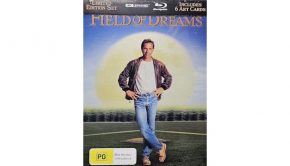Review: The Blind Swordsman: Zatoichi Blu-ray
Summary: Legendary Japanese film and television character Zatoichi returns in this splendid action spectacular directed by one of Japan's most beloved auteurs!
4.3
Japanese action!
Direction, screenplay by Takeshi Kitano who also stars as the blind swordsman himself, Zatoichi, and featuring Tadanobu Asano as the rōnin Hattori Gennosuke, Michiyo Okusu as Aunt O-ume, Yui Natsukawa as O-shino, Guadalcanal Taka as Shinkichi and Ittoku Kishibe as Ginzo.
In America there has been a long and (ig)noble habit of turning television shows, particularly from the 1960s, into movie productions in later years. Mission: Impossible is the most successful, but The Men from U.N.C.L.E., The Addams Family, Scooby Doo and The Flintstones, to name but a few of many, have all had their time in the cinematic sun. As for America, so too for Japan. From 1962 to 1989, there was a film series of Zatoichi starring Shintaro Katsu and from 1974 to 1979, a television adaptation screen, also starring Katsu. From this lineage, then, The Blind Swordsman: Zatoichi appeared in our cinemas in 2003.
Liberally sprinkled with flashbacks to enable the audience to better appreciate the background and motives of the various characters, The Blind Swordsman: Zatoichi is an entertaining blend of action and comedy, ably directed by Takeshi Kitano. As we can see in the extras, Kitano brings a lot of thought to this production. There is a rhythm to how the scenes play out and also to the sound design, which reaches its culmination in the dance scene at the end of the movie, as the villagers celebrate their liberation from the hands of the two warring criminal gangs, thanks to Zatoichi.
Kitano playfully fills the role of Zatoichi a blind, travelling masseuse who wields a cane sword with devastating effect. As we can see in the extras, a lot of thought and work went into choreographing the fight scenes, which themselves play out like some blood drenched balletic display. Perhaps he might drink too much sake, and his interest in gambling edges into problematic, but Zatoichi is a fun character willing to use his almost supernatural (dare I say, Daredevil-like) heightened senses to outwit and outfight his enemies. And those enemies are two rival criminal gangs, intent on battling each other to carve up as much business from the town they menace.
Kitano is adept at building a scene, and using it to explore larger truths. Take the geisha siblings, children of a family wiped out by a criminal gang. They have honed their craft and travelled the countryside, inveigling their way in to various places so they can exact revenge for the killings. At one point, staying with Zatoichi, they practice their music and dance. Kitano intercuts the younger versions with their current selves practicing the same dance . The dead eyes of the sister as she plays, watching her brother (who is forced to pretend to be a woman to enact the revenge) dance tells you everything you need to know about the cost not only of the death of their parents, but the extent of the toll this double life of pretend and revenge has had on them.
One other major character, the ronin Hattori Gennosuke is an interesting one. Hired against his dying wife’s wishes by one of the rival gangs, Gennosuke is a largely watchful, silent figure, enormously capable with the blade. He largely ignores his wife’s wishes not to join as a bodyguard and killer for the criminal gang, and seems to spend a large amount of time imagining how he would kill Zatoichi, which is important for the climactic battle. In Gennosuke, Kitano seems to be suggesting that a man wholly absorbed by his willingness to kill, loses everything that he has built up for such a selfish end.
The fight scenes, as you would expect, are balletic in terms of their choreography, and pretty graphic in regards to the outcome (lopped limbs, gallons of blood, general screaming and writhing). Yet Kitano presents them as a cathartic release from the tension the film periodically builds up, and everyone who does cop it in the neck (stomach, head, chest, arms etc) gets what they deserve. Indeed, the buildup to the finale, where hidden identities are revealed, cold blooded samurai wait to kill and kill again, and the cathartic dance number (!) at the end, are all indicators of a master director who knows his material, and revels in putting it on the screen.
CONCLUSION
All in all, The Blind Swordsman: Zatoichi is an entertaining movie that often surprises in the way it handles character, while presenting enough thrills and spills to demonstrate the strength of the genre to a Western audience.
EXTRAS
There’s a good selection of extras here. The behind the scenes crew provide fascinating insights into the production process. I was especially taken with the director of photography, who helped explain the rather washed out look to the visuals, which was down to the silver content in the film. Other members of the crew such as the fight choreographer, the music designer and the sound technician are all given a great opportunity to explain not only how they do their job, with behind the scenes footage to assist, but also how they worked with Kitano to help realise his vision.
The Making Of is a winner as well, taking us from the announcement of the movie to the wrap party and its cinematic release. Great to see some 2003 fashions again! The commentary track dating back to 2004 might be a little dry, but is full of those delightful insights that only an expert in the field is able to provide. Well worth the price of admission.







